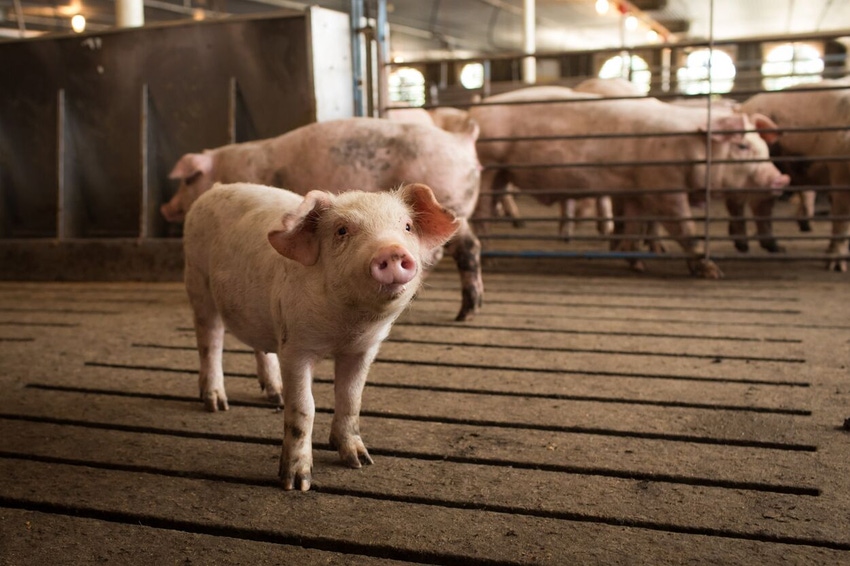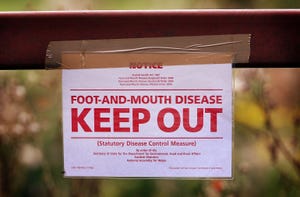What happens if JEV comes to North America?
Experts say don't ignore an animal health event on farm or assume same diagnosis as last time; communicate, seek professional help.

Japanese encephalitis virus can infect mosquitoes, horses and humans, but experts say if the United States were to have an introduction of the flavivirus, it would most likely be detected first in the country's domestic swine industry.
"Given our discussions today with our Australian colleagues, given the network of laboratories that we have, the work that we've done with the swine industry, in my opinion it'd be very likely that we'd detect it in our swine population first. Whether that is the first population to truly be infected, that's another conversation," said Michael F. Neafsey, assistant director of animal welfare operations for USDA’s Animal and Plant Health Inspection Service.
"I agree with that, unless it follows the type of pattern that West Nile did, with having some sort of unexplained die off in birds. Now we didn't hear that from Australia, but there's got to be some sort of a health trigger that causes an investigation in order to be able to find it here," said Paul Sundberg, executive director, Swine Health Information Center. "So, an unexplained die off in birds might be one, but my expectation would be that with the diagnostic lab systems that we have for veterinary medicine now, and their interest in production, that the domestic pigs would be the first one we'd find it in … subclinical or undetected infection could be circulating, but detected first in our commercial pigs because of the diagnostic systems we have."
"The reason I don't think we're going to detect it in humans is that, it looks exactly like our other viruses in terms of the brain infection, the symptoms, and then the main means of diagnosis is serological, and you've got the serologic cross reactivity," said Susan Hills, medical epidemiologist, Division of Vector-Borne Diseases, with the Center for Disease Control. "So almost inevitably somebody would test for West Nile or encephalitis. It will come up positive because there's this post reactivity when that's that virus group and nobody's going to take it the next step of thinking maybe this is JEV, maybe we should do like reduction neutralization tests for confirmation, and this is particularly because there’s not going to be clusters of human cases. One in a hundred infections is actually symptomatic, so you're not going to see suddenly a group of humans getting infected. They're going to be dispersed, so I do think there will be some sort of event, most likely with pigs where it would be detected."
Neafsy, Sundberg and Hills shared their insight in a panel discussion entitled, "What happens if JEV comes to North America?" during a recent JEV symposium. Held Oct. 17-19, in the Center for the Ecology of Infectious Diseases at the University of Georgia, the Japanese Encephalitis Virus: Emerging Global Threat to Humans & Livestock conference was focused on further understanding the current JEV outbreak in Australia, and JEV's potential for global impact on human and domestic animal populations.
A zoonotic arbovirus that is endemic in much of Asia and the western Pacific region, JEV produces neurological disease in pigs and horses as well as reproductive failure in pigs. Most JEV infections in pigs are subclinical.
In sows, infection with JEV before 60 to 70 days of gestation can cause abortion, fetal mummification or stillbirth, or the birth of weak piglets. Infected boars can have reduced sperm motility and develop testicular edema and temporary infertility. Piglets born alive may develop encephalitis, displaying tremors and convulsions.
Sundberg says while outreach and education to backyard and non-commercial owners is an important step, technical outreach and investigation throughout the industry is critical.
"The American Association of Veterinary Diagnostic Labs and the diagnosticians of the veterinary diagnostic labs see abortions, mummified fetuses regularly and without reaching a diagnosis. One of the challenges is to ensure that they have JEV as a differential in their minds to test for that. Also practicing veterinarians, the same type of thing," Sundberg said. "The videos of shaker pigs that we saw from Australia, can be a thing out on our farms. So JEV needs to be kept in mind by veterinarians, so those types of investigations can happen as well."
One question that came to the panel was: what about capitalizing on the existing population by setting up a sentinel system? Sundberg said one of the lessons learned from all of the African swine fever planning that's gone on in since 2018 is about the analysis of surveillance streams and the efficiency of different surveillance streams to be able to detect either the first infection or to use them to show negative status for the country.
"While sentinel pigs in any spot may be a surveillance tool or a surveillance stream that could be used, I think that the first step needs to be the folks probably at the USDA Center for Epidemiology and Animal Health in Fort Collins to do an analysis of the risks and the benefits of different surveillance streams so we can focus on those that will give us the most return for the investment that would be put into it," Sundberg said.
Another question raised from the audience was the potential for mosquitoes to introduce JEV to a domestic swine herd if most barns are curtained or fully contained. Neafsy noted that at least one of the Australia infected farms was fully enclosed but had slotted floors with liquid underneath so there was some opportunity for mosquitos to come in, which would be similar to the setup many U.S. commercial operations have with slatted floors and slurry storage underneath.
Sundberg said it is common in the fall for the U.S. swine industry to hear feedback from packers that there's an increase in fly bites and mosquito lesions in the hides. "I don't know if that's an indication that there are more or less mosquitoes inside than outside, but it certainly is an issue," Sundberg said.
One audience member noted the food safety messaging in Australia seemed to be received positively by the public after the JEV outbreak. Would the United States have a similar public reaction if there was a JEV introduction? Sundberg said he didn't think that question could be answered definitively, especially in today's environment.
"There is on behalf of the National Pork Board and National Pork Producers Council a lot of planning for consumer messaging around a variety of difficulties," Sundberg said. "Foot and mouth disease, for example, has a cross species working group which is a communications working group, that has been talking specifically about that for a couple of decades. There's a lot of preparation that has happened with that, and planning for that specifically, but public receptivity I think is still unknown."
Even though JEV is currently infecting piggeries more than 9,000 miles away, U.S. pork producers should be attentive, said the panel.
"As it is with a lot of other transboundary and even endemic diseases, the take home message is vigilance. Don't ignore an animal health event on your farm by assuming that it is the same thing that the doc found last time. Don't ever do that," Sundberg said. "Always get that professional diagnostic help and question the professional diagnostic help that you get, the answers you get. Question your veterinarian and ask about the likelihood of the success of that diagnostic testing … I think that's probably one of the most important things that we can do as producers."
While biosecurity is a 24/7 issue, Sundberg said biosecurity is a little different with vector transmission, and that's why it is important to not make assumptions on farm.
Neafsy said that is why it is essential pork producers build networks early and improve communication at the local and regional levels.
"Whether you're talking within your particular swine network or you're talking to your neighbors, you're talking to local associations, you're talking with your state animal health officials, whomever it may be, you have some outlet to share these issues," Neafsy said. "Develop a network, lean on that network to share ideas, share what things are working, what things are not … don't fall into well this is the same old thing because one neighbor could say I'm having these death losses and they just sit by themselves in a vacuum and have these death losses that their neighbor could be experiencing or somebody within their network could be experiencing the exact same thing."
About the Author(s)
You May Also Like





